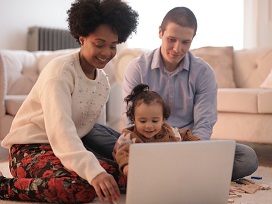Skip to content

There has been some new information recently published regarding the use of screens to help parents teach their young children. Let me start by saying, all information is valuable whether we agree or disagree. The purpose of this post is not to argue or debate the information, but rather provide parents additional information from the perspective of a professional who helps families teach their little ones.
With over 20 years of experience, I have seen many shifts in how children learn. Also, I have seen shifts in how their caregivers learn. While I come from a generation that did not have constant access to screen time, or information in the palm of my hand at any given moment, I can see how it can be a useful source for parents. However, especially over the last 10 years or so, in some situations a screen has replaced very important face to face interactions between young children and their caregivers. There are a ton of shows out there that have wonderful teaching/learning opportunities. It is crucial to remember that young children learn best through PLAY. This means, they are exploring their environments utilizing all of their senses. If a screen is always on, what senses are they using? Vision and hearing. Two senses. Common sense should tell you, this is not a good thing.
Children need social interaction. Guess who the first people that provide this are? You, the caregivers. Learning faces and non verbal language is a crucial part of development. They need to learn not only about their own feelings, but the feelings of others. How do we typically show our emotions? Through our facial expressions. An excess amount of screen time can not replace this.
Look, I get it. Parenting is hard, it’s exhausting at times. Sometimes, we need to get things done without a tiny human hanging on us. It is entirely possible to have a balance. When you feel like you need to use it, just be sure to limit the amount of time they are watching it alone. When you need to veg out, try talking with your little one about what is happening in the show. It is also important for them to learn to disconnect from the bright vibrant colors and fast moving images to attend to you and then go back to what is happening on the cartoon, and back to you, and back to the show. So on and so forth.
Overall, a screen should not be used as a replacement for you or the primary way they are learning. It has been a proven fact for many, many years. Children learn best through play and exploration. Also, you are the most important play partner in their lives and their first teacher. Make the best of learning to be a kid again with your kid(within reason, haha!).

Over the last 19 years working in pediatrics, mostly Early Intervention, I have experienced many parents/caregivers who have difficulty navigating their child’s emotions. Since I am there to help parents/caregivers help their child communicate, naturally we usually end up talking about the frustration their kiddo(s) are demonstrating. Inevitably, a huge part of my job comes down to teaching families to navigate and/or manage behaviors.
So, many parents ask, “When should I begin teaching my child(ren) about emotions?”. Most scholars believe that teaching children the “feeling words” and how to use them should begin around the age of 3. They believe this is when children begin to more fully understand their own and other people’s facial expressions and can use the words to identify emotions. This may be true, however, after working in this field for so long, I believe we can begin the teaching of them earlier.
Why not talk about those feelings they are having(or that you’re having) when they begin to demonstrate frustration, excitement, sadness, etc.? The earlier they hear these words and begin to see emotions on other people’s faces, maybe the earlier they will begin to identify emotions. Could this also lead to them learning to navigate how to manage emotions a little earlier on? Possibly. If anything, it may teach us adults how to navigate our emotions in order to demonstrate healthy ways to manage them. As parents/caregivers, we are the biggest source of influence for them in most situations.
Besides labeling emotions as they are feeling their big feelings or watching others demonstrate emotions, there can be other ways to begin teaching feeling words at a young age. You can point out characters in books while readying short stories, look through photos, or while they are watching their favorite shows. This can be as simple as pointing to faces and describing the emotion very simply, such as, “Oh, he’s sad”, or “Look how happy she is!”. Nothing too complicated. The least amount of words the better when they are little. You can show them those emotions on your own face and change the tone in your voice as you describe. I truly believe it is never to early to begin using feeling words while you talk to your toddler or preschooler!